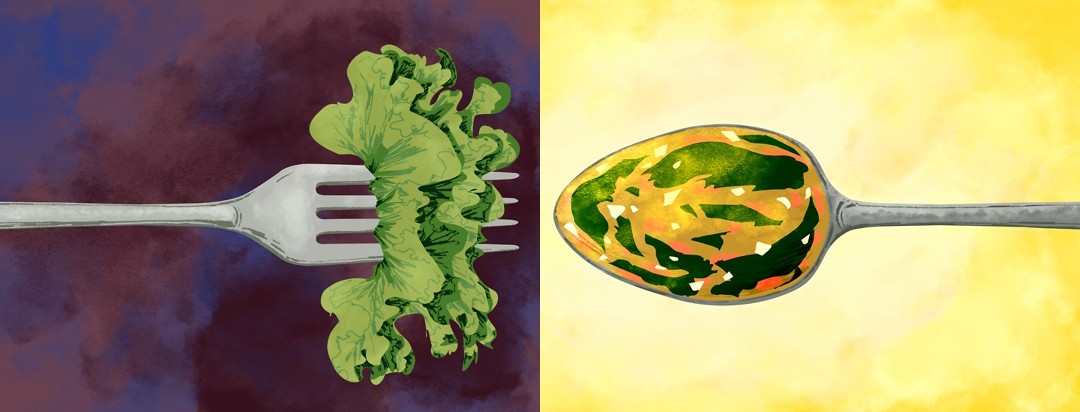Are You Eating the Right Textures for Your IBS?
To many people, the classic image of healthy food might look something like a giant bowl of salad with a lot of raw roughage and crunch in it. However, for people with IBS, this can also be a recipe for a giant flare-up! Even moderate-sized portions of fibrous or coarse foods, though extremely healthy, can trigger abdominal bloating, diarrhea, bowel urgency, and gas in those with irritable bowels. Challenging textures can excessively burden a sensitive digestive system, and large volumes of raw foods often trigger the gastrocolic reflex in an IBS gut.
How textures can help IBS
Utilizing texture modification in the diet can be a very simple yet effective way to sustain digestive comfort throughout the day. If someone has had a troublesome history with nuts, perhaps nut butter can still be their friend. If kale salads feel awful, perhaps a kale and veggie soup will feel great! Rather than focusing on a restrictive diet plan, see how preparing foods in different textures and temperatures may make it more easily digestible, and enjoyable for you.
Be kind to your GI system
There are many analogies and metaphors out there for the digestive tract – a plumbing system, a furnace, garbage disposal, a blender, and an assembly line. Whichever one you go with, they all have one theme – they are by no means invincible! And in fact, they tend to run best when you take care of them and put easy-to-break down contents in them. Now, some plumbing systems or blenders or garbage disposals simply are in better shape than others. Some are older; some have some repaired parts, broken parts, or parts that are just pretty shaky when the system gets going. So, if that’s you, and if you have IBS that may very well be you, think about being kind to those parts when you can! Think about what you’re having them go to work on.
This doesn’t mean you need to treat your digestive system as a baby (although you can baby it sometimes!), but it does mean you’ll want to be conscious of how hard you’re making it work. If you have hypersensitivity, consider helping your body out by selecting foods that won’t be too hard on it.
Consider softer textures
Cook it!
Play with more cooked versus raw foods in your diet. When you eat raw fruits and vegetables, your body has to expend much more energy to break down the fibrous textures. Consider steaming or sautéing with olive oil for easier digestion. Example: large salad with crunchy quinoa versus soft grain bowl with cooked veggies.
Crunch it!
Unless you have oral/chewing problems, we all love a good crunch. But some crunchy foods can be just as crunchy down below. Think about whole nuts, thick hard pretzels, popcorn, or granola going into your sensitive plumbing or your blender – it takes work to break them down! Now think about nut butter, a soft pretzel, a thin rice cake, or cooked oatmeal. These are much easier on the system! This doesn’t mean you have to eliminate, nuts, for example, just eat them in another tasty form. (another example: coarse, country bread vs. soft wheat). Blend some nuts or oats into a smoothie, to add flavor, and it may also be better tolerated on a flare-up day.
SOUP it up!
Soups can be an amazing solution for someone with hypersensitivity. They can be nutritious and extremely easy on the digestive system. Think of a large salad of raw vegetables versus a cooked bowl of soup – both are nutritious but one might cause bloating or discomfort for you. As we head into winter, they’re perfect and cozy! Though a chilled soup is also lovely in the warmer weather. Just look out for high-sodium. Opt for veggie-rich soup!
Go big or go home, or maybe not
Consider volume – what happens if you shoved too much food into the garbage disposal at once? What if you put more food in the blender than it could handle? Sometimes modifying the volume of food can be really helpful.
This doesn’t mean you need to eat less! It could just mean you eat the food in a different form – same calories, same energy, still delicious!
Examples of texture modifications for IBS
- A smoothie of 3 whole fruits will take up a lot less immediate space than eating those 3 fruits all at once and you did some pre-work by breaking down all that fiber for your body!
- 2 cups of raw kale versus 2 cups cooked kale – shrinks down, you still get the nutrients, but in an easier to digest form
- A large bowl of chickpeas vs. smaller side of hummus
- A bowl of trail mixes vs. fruit/nut bar like a RxBar or Larabar
Consider being gentler for your digestive system for optimal function! You don’t need to eliminate whole foods or food groups! Think about ways of altering them so you can still enjoy the taste and reap all the nutritious benefits. Share with us what texture modifications work for you in the comments!

Join the conversation